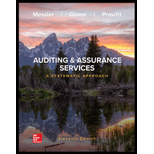
EBK AUDITING & ASSURANCE SERVICES: A SY
11th Edition
ISBN: 9781260687668
Author: Jr
Publisher: MCGRAW-HILL LEARNING SOLN.(CC)
expand_more
expand_more
format_list_bulleted
Concept explainers
Question
Chapter 5, Problem 5.18MCQ
To determine
Concept Introduction:Auditor provides his opinion on the basis of the conclusion drawn from the audit evidences obtained during the process of the audit. Some audit evidences are received from the third party and some from the management.
To choose: The correct process for testing the existence assertion for an asset.
Expert Solution & Answer
Want to see the full answer?
Check out a sample textbook solution
Students have asked these similar questions
Need answer.
Solve plz now
Precious metal qn solve .
Chapter 5 Solutions
EBK AUDITING & ASSURANCE SERVICES: A SY
Ch. 5 - Prob. 5.1RQCh. 5 - Prob. 5.2RQCh. 5 - Prob. 5.3RQCh. 5 - Prob. 5.4RQCh. 5 - Prob. 5.5RQCh. 5 - Prob. 5.6RQCh. 5 - Prob. 5.7RQCh. 5 - Prob. 5.8RQCh. 5 - Prob. 5.9RQCh. 5 - Prob. 5.10RQ
Ch. 5 - Prob. 5.11RQCh. 5 - Prob. 5.12RQCh. 5 - Prob. 5.13RQCh. 5 - Prob. 5.14RQCh. 5 - Prob. 5.15RQCh. 5 - Prob. 5.16RQCh. 5 - Prob. 5.17MCQCh. 5 - Prob. 5.18MCQCh. 5 - Prob. 5.19MCQCh. 5 - Prob. 5.20MCQCh. 5 - Prob. 5.21MCQCh. 5 - Prob. 5.22MCQCh. 5 - Prob. 5.23MCQCh. 5 - Prob. 5.24MCQCh. 5 - Prob. 5.25MCQCh. 5 - Prob. 5.26MCQCh. 5 - Prob. 5.27MCQCh. 5 - Prob. 5.28MCQCh. 5 - Prob. 5.29MCQCh. 5 - Prob. 5.30PCh. 5 - Prob. 5.31PCh. 5 - Prob. 5.32PCh. 5 - Prob. 5.33PCh. 5 - Prob. 5.34PCh. 5 - Prob. 5.35PCh. 5 - Prob. 5.36PCh. 5 - Prob. 5.37PCh. 5 - Prob. 5.38PCh. 5 - Prob. 5.39P
Knowledge Booster
Learn more about
Need a deep-dive on the concept behind this application? Look no further. Learn more about this topic, finance and related others by exploring similar questions and additional content below.Similar questions
arrow_back_ios
SEE MORE QUESTIONS
arrow_forward_ios
Recommended textbooks for you
 Auditing: A Risk Based-Approach (MindTap Course L...AccountingISBN:9781337619455Author:Karla M Johnstone, Audrey A. Gramling, Larry E. RittenbergPublisher:Cengage Learning
Auditing: A Risk Based-Approach (MindTap Course L...AccountingISBN:9781337619455Author:Karla M Johnstone, Audrey A. Gramling, Larry E. RittenbergPublisher:Cengage Learning Auditing: A Risk Based-Approach to Conducting a Q...AccountingISBN:9781305080577Author:Karla M Johnstone, Audrey A. Gramling, Larry E. RittenbergPublisher:South-Western College PubBusiness/Professional Ethics Directors/Executives...AccountingISBN:9781337485913Author:BROOKSPublisher:Cengage
Auditing: A Risk Based-Approach to Conducting a Q...AccountingISBN:9781305080577Author:Karla M Johnstone, Audrey A. Gramling, Larry E. RittenbergPublisher:South-Western College PubBusiness/Professional Ethics Directors/Executives...AccountingISBN:9781337485913Author:BROOKSPublisher:Cengage

Auditing: A Risk Based-Approach (MindTap Course L...
Accounting
ISBN:9781337619455
Author:Karla M Johnstone, Audrey A. Gramling, Larry E. Rittenberg
Publisher:Cengage Learning

Auditing: A Risk Based-Approach to Conducting a Q...
Accounting
ISBN:9781305080577
Author:Karla M Johnstone, Audrey A. Gramling, Larry E. Rittenberg
Publisher:South-Western College Pub

Business/Professional Ethics Directors/Executives...
Accounting
ISBN:9781337485913
Author:BROOKS
Publisher:Cengage